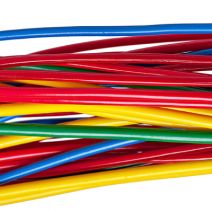Ferrum Technology Services Blog
4 Easy Ways to Take Control of Your Network’s Cables
 Until we’ve reached a day where wires are obsolete and every device connects wirelessly to its needed network, wires and cables will always be an integral part of your company’s IT infrastructure. Since you’re stuck having to deal with wires, you might as well know how to effectively manage your cables so that they’re not slowing you down.
Until we’ve reached a day where wires are obsolete and every device connects wirelessly to its needed network, wires and cables will always be an integral part of your company’s IT infrastructure. Since you’re stuck having to deal with wires, you might as well know how to effectively manage your cables so that they’re not slowing you down.
Here are four proven ways to keep your cables organized.
Use Different Colored Cables for Different Signal Types
When all of your cables are the same color, it makes tracking down what’s connected to what very challenging and time consuming. If your different signal types are color coded, you’ll be able to quickly know what goes where, instead of having to follow a single cord through a tangled mess of similarly-colored cords. This one-color-cord system wastes a lot time, and it’s unfortunately used by many SMBs that don’t have professional oversight of their systems. Therefore, spending a little extra money to buy different colored cables will more than pay for itself.
Label Your Cables
In addition to rhyming, labeling your cabling can save you loads of time when it comes to tracking down what goes where and what’s the purpose of the cable in question. When it comes to making labels made for your cables, you’ll want to include specific information like:
- What signal type (audio, video, serial, network, VGA, etc.)
- The source of the signal
- The destination of the signal
- A unique identifier (optional)
Of course, even by just including some of this information on your cables, you will save yourself headaches in the long run from having to figure out these details on your own.
Use Cable Routing and Service Loops
When laying out your cables, be mindful of the future and make it as easy as possible for IT technicians to service your equipment. If you’re not intentional about cable routing then you're going to end up with crisscrossing cables that will make you want to jump in frustration every time you need to remove a single piece of equipment from your network. OcehanDataRat explains:
This means running the cables in a way that allows individual pieces of equipment to be removed from the rack far enough to inspect and remove/reattach any connected cables. The additional wire length that allows the gear to be removed without first disconnecting any cables is called a service loop. Determining how long to make a service loop is a balance. Having too long of a service loop creates its own problems.
Run Two Cables For Every Drop
If a cable gets pinched or damaged, you’ll be glad there’s an extra one to use. Hopefully this scenario is pretty rare, but it also doesn’t hurt to have an extra cable when it comes time to expand. If you start hiring more staff, you’ll be glad you don’t need to run additional wires before they get started. Even if you simply leave the cables unterminated, it’s always more cost effective to run two at once than having to run another later.
Ferrum Technology Services can assist you with planning your network and routing your cables to make it as efficient as possible. In the end, it will be well worth the time and investment to set up your network right for whenever your IT experiences an issue. Keep in mind, if you’re going to run new cables, it’s a good idea to consult with an expert because there are many more best cabling practices designed to ensure a stable network.
Ultimately, these cabling best practices show the advantage of being proactive about your IT so that you can effectively take care of issues that will eventually occur at a later time. This proactive approach to IT saves you time and money, and you should look for ways to proactively maintain all of your company’s technology in order to achieve maximum network productivity. Call us at (847) 697-3282 to learn more.
